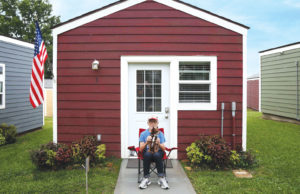scramble to save lives, provide food and deliver emergency medicine,
another urgent dilemma must be confronted: finding adequate shelter for
the displaced and homeless.
One million Haitians — some 200,000 families — need immediate shelter, the
Living conditions in
are so dire that hordes of residents who survived the earthquake are
climbing aboard overcrowded buses, ferries and dinghys in a bid to flee
the urban squalor for the countryside.
Makeshift camps in outlying rural areas present
their own concerns, from disease to safety. An aid group warned
Wednesday that, in some cases, waves of earthquake victims are
venturing to rural towns that lack the capacity to absorb the masses.
In an effort to help ease the displaced population,
Haitian authorities dispatched a fleet of buses Wednesday morning to
the largest camp in the hard-hit Petionville, where several thousands
squat.
The buses — 11 in all in Petionville — were to carry people to major cities such as Gonaives,
Wednesday that it has started work on a large temporary settlement in
the suburb of Croix des Bouquets. A battalion of Brazilian troops
deployed by the
Aid groups are also launching the process of setting up shelters that can house earthquake victims for an extended period.
in the 1990s, said it is crucial for aid workers to move displaced
people out of makeshift camps quickly and into more organized and
sanitary forms of housing.
“You have to resettle the displaced people with food, water, and shelter and protection,” said Knight, who now works for
a logistics consulting firm working with USAID. “You try as much as
possible to avoid camp situations. They start a downward spiral.”
The materials needed for shelters include tents,
mosquito nets, blankets, sleeping mats, hygiene kits with items like
toothbrushes, and kitchen kits for cooking.
“First there is the immediate survival phase, which will continue and remains very critical,” said
Torres said adequate staffing is also required. For
instance, she said, it’s vital to have child care in the shelters both
for safety reasons and so parents are free during the day to seek work
“and rebuild their lives.”
already delivered “four or five planeloads” of materials, including
items needed for shelters, Torres said. The organization, which was
donated warehouse space in Medley, is setting up its
At a
Crowley said shelter material will be used for “eventual settlement support of affected populations.”
Thus far, USAID reports it has shipped to
nearly 24,500 hygiene kits that will serve more than 121,000 people;
and 700 rolls of plastic sheeting to support the shelter needs of about
35,000 people.
But picking sites in
and setting up shelters is only just beginning. Experts say the process
of transitioning from shelters to more robust, permanent housing must
occur quickly too.
The reason: the onset of hurricane season in June.
“Twenty-two weeks from hurricane season, and hundreds of thousands of people in temporary housing,” warned
“There’s a chance for what we call a compound disaster here.”
—
(c) 2010, The Miami Herald.
Visit
Distributed by McClatchy-Tribune Information Services.













